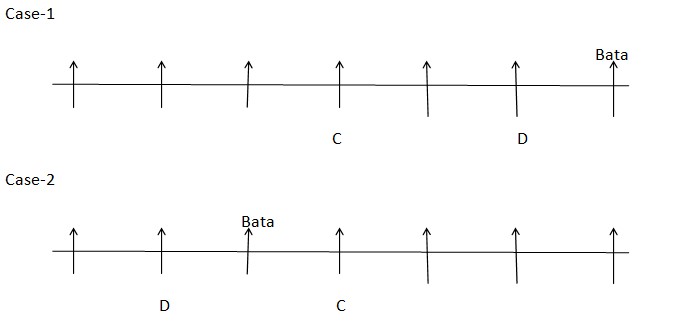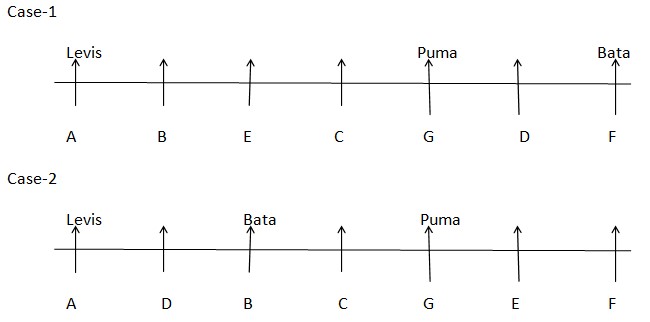Question
Who among the following sits at one of the extreme
ends? Study the following information carefully and answer the questions given below: Seven persons A, B, C, D, E, F and G are sitting in a row facing towards the north but not necessarily in the same order. Each one of them likes different shoes i.e., Reebok, Nike, puma, Levis, adidas, woodland and Bata but not necessarily in the same order. The one who sits immediate right of D likes Bata. D sits 2nd from one of the extreme ends. Only one person sits between D and C. A sits 4th to the left of G, who sits adjacent to C. Only one person sits between F and G, who likes puma. More than three persons sit between A and F. More than two persons sit between the one who likes puma and the one who likes Levis. B sits to the left of E. B is not an immediate neighbor of A. Neither D nor C likes woodland. The one who likes Reebok sits 3rd to the left of the one who likes woodland. E does not like Nike.Solution
As per the given information, the one who sits immediate right of D likes Bata. D sits 2ndfrom one of the extreme ends. Only one person sits between D and C. Here we have two possible cases i.e.  A sits 4th to the left of G, who sits adjacent to C. Only one person sits between F and G, who likes puma.
A sits 4th to the left of G, who sits adjacent to C. Only one person sits between F and G, who likes puma.  Case-2
Case-2  More than three persons sit between A and F. B sits to the left of E. More than two persons sit between the one who likes puma and the one who likes Levis.
More than three persons sit between A and F. B sits to the left of E. More than two persons sit between the one who likes puma and the one who likes Levis.  B is not an immediate neighbor of A. Here Case 1 gets eliminated. Neither D nor C likes woodland. The one who likes Reebok sits 3rd to the left of the one who likes woodland. E does not like Nike. So the final arrangement will be,
B is not an immediate neighbor of A. Here Case 1 gets eliminated. Neither D nor C likes woodland. The one who likes Reebok sits 3rd to the left of the one who likes woodland. E does not like Nike. So the final arrangement will be, 
Who has the power to make any provision in relation to the acquisition and termination of citizenship?
In what language is the film "2018: Everyone is a Hero," selected by the Film Federation of India as India's official entry for Best International Featu...
What is the local name of the Elephants Falls?
Lakshya Sen won the men's singles final at the India Open badminton tournament, 2022 by defeating ___________.
Currently NATO has ______ Member States.
Which is the largest continent in the world?
Mark Rutte, the current NATO Chief, served as the Prime Minister of which country?
Which of the following is NOT a conductor?
Who was elected as the 36th president of the BCCI in 2022?
The Reserve Bank of India (RBI) has approved SBI Mutual Fund, along with other SBI group companies, to hold a 9.99% stake in which private bank?
Relevant for Exams:


